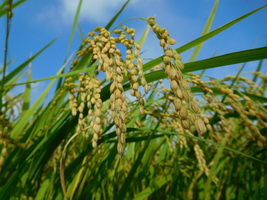
Engineered Rice with Adjustable Immune System Shows Resistance to Multiple Diseases at Once
May 31, 2017| |
 Scientists have successfully engineered a rice plant with an adjustable immune system to make it resistant to multiple diseases at once without decreasing its yield.
Scientists have successfully engineered a rice plant with an adjustable immune system to make it resistant to multiple diseases at once without decreasing its yield.
"For as long as I have been in this field, people have been scratching their heads about how to activate a defense system where and when it is needed," says Jonathan Jones, a professor at the Sainsbury Laboratory in Norwich, U.K. "It is among the most promising lines of research in this field that I have seen."
The gene known as NPR1 has been explored by many scientists to improve the immune system of rice, wheat, apple, and other plants. Duke University scientist, Xinnian Dong, has been studying this gene for two decades and referred it as the "master regulator" of plant defense. When this gene is turned on for immunity, it backfires on the growth of the plant resulting to stunting and zero production for farmers. This led Dong and other researchers to another immune system-activating protein in Arabidopsis, the TBF1. They discovered a complicated system that involves readily available messenger RNA molecules that encode TBF1, and instantly translating these molecules into TBF1 proteins, causing an immune response. Dong copied the segment of the DNA that functions as a switch for immune response and placed it alongside and in front of the NPR1 in rice. This led to a rice plant with boosted immune system strong enough to ward off pathogens in short periods of time to avoid stunting. The engineered rice has shown effective resistance against rice blight (Xanthomonas oryzae pv. oryzae), leaf streak (X. oryzae pv. oryzicola), and blast disease (Magnaporthe oryzae).
Read the original article from Science.
| |
Biotech Updates is a weekly newsletter of ISAAA, a not-for-profit organization. It is distributed for free to over 22,000 subscribers worldwide to inform them about the key developments in biosciences, especially in biotechnology. Your support will help us in our mission to feed the world with knowledge. You can help by donating as little as $10.
-
See more articles:
-
News from Around the World
- Global Team Led by ICRISAT Re-sequence Pigeonpea Genome
- Journalists in Uganda Urged to Support Passing of Biotech Law through Factual Reporting
- Kenya Biosafety Regulators Commend Malawi's Bt Cotton National Performance Trials
- Two New Proteins Connected to Plant Development Identified
- Draft Genome of Spinach Published by Researchers from US and China
- Research Team Discovers Gene that Impacts Soybean Nodule Development
- Engineered Rice with Adjustable Immune System Shows Resistance to Multiple Diseases at Once
- Japan, A Potential Biotech Sugar Beet Country
- Study Shows Climate Change to Cause 23% Decline in Crop Production by 2050s
-
Research Highlights
- Researchers Study the Effect of Calcareous Soil on Bt Protein Expression and Efficacy in the Field
- CAAS Scientists Develop Herbicide Resistant Cotton with Low Glyphosate Residues
-
Beyond Crop Biotech
- PtrMYB57 Transcription Factors Negatively Regulate Anthocyanin and Proanthocyanidin Synthesis in Poplar
- Plant-Produced Vaccine Candidate for Bluetongue Virus
-
Plant
- CRISPR-mediated Targeted Mutagenesis in Grape
- Simultaneous Targeting of Multiple Gene Homeologs to Alter Oil Production in Camelina
-
Read the latest: - Biotech Updates (December 10, 2025)
- Gene Editing Supplement (November 26, 2025)
- Gene Drive Supplement (February 22, 2023)
-
Subscribe to BU: - Share
- Tweet
